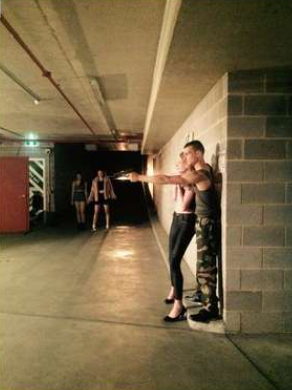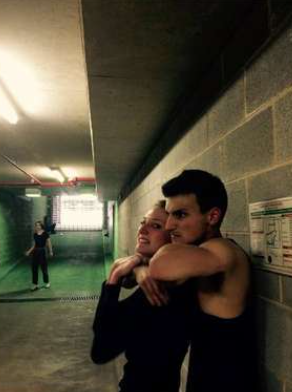

Roberto Zuko arrested in Australian garage


By: Sabah Alanbari
Bernard-Marie Koltes
(1948-1989) is a French playwright described by The Times as the pioneer of a
new style in dramatic writing. His play (Roberto Zucco) was the last of his
great works which found its way to the Australian theatre. The play is staged by
the Australian director (of Portuguese origin) Paolo Castro
who created an outstanding show performed not on a regular stage but in a car
park in
Adelaide CBD.
The play is based on the true story of Zucco who was
imprisoned for killing his father. He escaped prison,
and
later to become,
because of his deranged behaviour and horrific acts, the character of epic
stories.
In
this show, the Paolo Castro trapped Bernard’s characters
in a confined space, with narrow entrances and exits, huge concrete pillars, and
an elevator. All of them
are
part of the car park, the only
added elements to
the set are a middle size table, two chairs, and a wooden door fixed to the
ground on a wooden frame.
The
place is almost empty, except the vehicle which was already in the car park and
the limited
set.
Despite this emptiness, the actors were able to fill the space with their
bodies, moving here and there in an artistic and
way.
This
was perfectly performed. The
actors
occupied all the space and were able to use it
to
express themselves
proficiently
and with high technical skills.
You
feel, sitting on the ground or on wooden benches, as if you were a part of the
show, or as if you
had entered
the place to see what is going on.
The moment you get into the dark garage space looking for a place to sit,
a security guard sheds his
torchlight
in your eyes,
check if you
are
the character
they are
searching for, and then acknowledges that you're
just
part of the audience and not a wanted criminal.
The show starts with the interplay between the actors and the audience who found
itself hostage to the place while following the course of events and the changes
that take place on the garage’s ground/stage set in this tight underground
space.
After that, an actress enters from the wooden door carrying a basket of clothes,
followed by afierce
looking
young man. He moves around her
proffering
angry words, trying to force her to tell him something dear to him. He is
Roberto Zucco, who we discover from the scene, an unstable man who doesn’t think
twice to choke, shoot,
or death,
whoever doesn't cooperate with him. From his very first
entrance on stage, he appears as a killer, a character unsettled in one thought
or sate, never in peace with himself or others,
enraged with himself as much as with the others, who seem to live an eternal
tension screaming loudly in other’s faces.
The director reveals this collective tension in a silent scene when the actor
stalks the actress
until he grabs her neck and chokes her revealing his internal violence,
fuelled by his desire for revenge.
The actress falls, but gets up again and kisses him passionately. This scene
reveals the sadistic part of Zucco’s character, as well as how attractive he is
to
vulnerable
women he’s in a relationship with.
He’s a troubled man, confused, and very unsecure.
He
prevents the women, whose innocent child he just murdered,
from following him, but soon changes his mind to let her go
with
him…
It must be noted here how the director
takes advantage of the configuration and all the parts of the garage. For
instance, he uses the elevator to mark the entrance and exit of the actor.
This is another
example of the clever usage of the restricted elements of the stage and the
barren setting.
Zucco has relationships with other women that are all controlled by his
turbulent and destructive
temper.
Ssometimes
he is a lover who melts in love and desire for them, sometimes he is their
compulsive killer, and at
another times
he calls for peace. The police was in constant search for him and followed his
traces. And yet, it was difficult for them to find him. However, the woman whom
he
had
raped as a child and fell deeply in love with him, decided to
look
for him everywhere, challenging her brother who once had a bloody fight with
Zucco in a scene skillfully created by the director.
The girl
by chance sees
him and runs towards him calling his name, which draws the attention of two
policemen who arrest him at gun point before sending him to jail.
The director, here, used
the cars exit and entrance gate
to symbolize the
jail. He succeeded in manipulating the place and its components technically, to
create
sense, and to make the place seems more in accord
with the set of events. This coherence creates a sense of harmony convincing
the spectator
that these events actually happened here.
And because Zucco has a turbulent and complex character, his arrest attracted
the attention
of the media
which enter the place to take pictures of him, and write reports about all the
strange and weird things he
has
done.
The show ends at this point, without closing curtains, as if these many ramified
events also part of our lives. For everything in our
lives has to come to an end, but without closing a curtain.
So, what did Paolo Castro, the director of this show want to tell us? He wanted
to say that Roberto is one of us, a member of
a
social group with its own system, system
characterized by its cruelty and tense relations which burdens
him
heavily,
pushing him to release all his repressed energy as a latent evil force.
This concept occupies Castro’s mind. This
is
why he
had previously chosen my play
“Questions of the executioner”
aalthough
he didn’t have the chance to direct it on stage due to some example
circumstances. My play also explores the concept that tense social circumstances
have the ability to create executioners,
murderers, and serial killers.
........................................................................................
* This article dealt the performance play on Tuesday 28/ 11/ 2017.